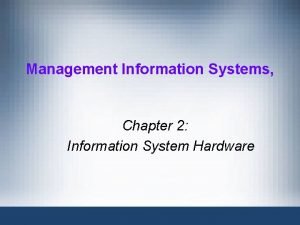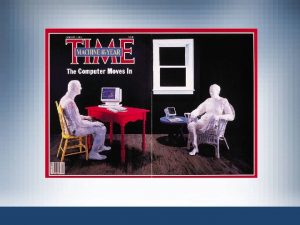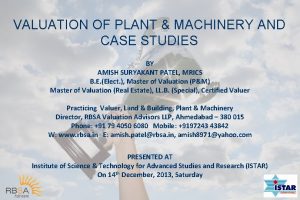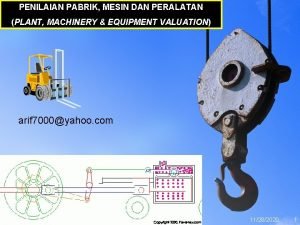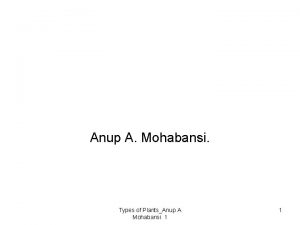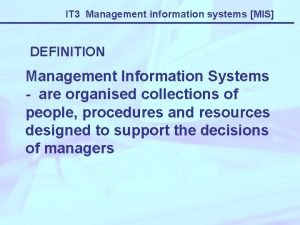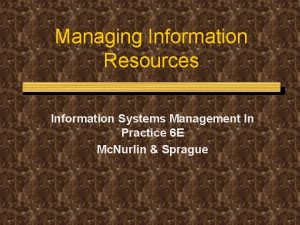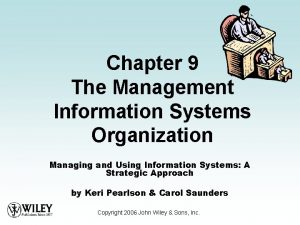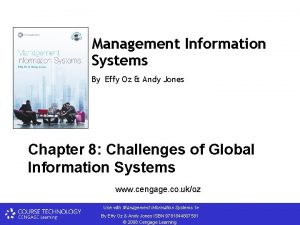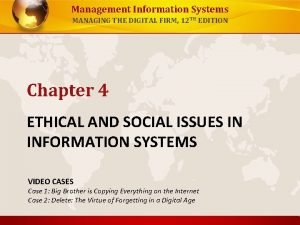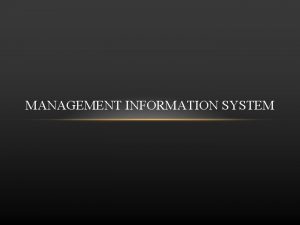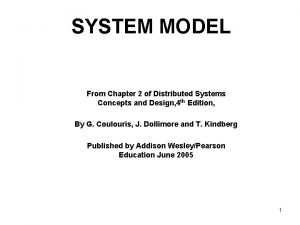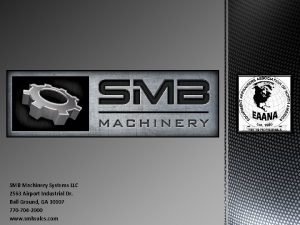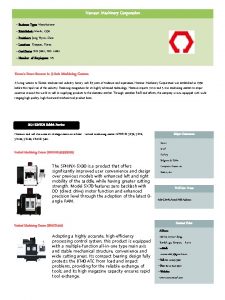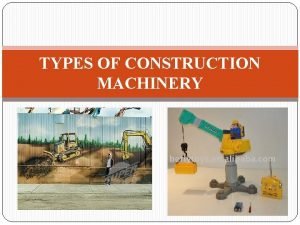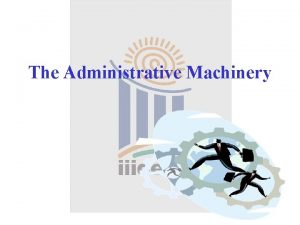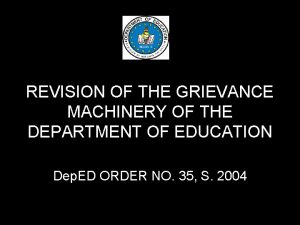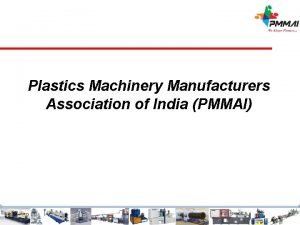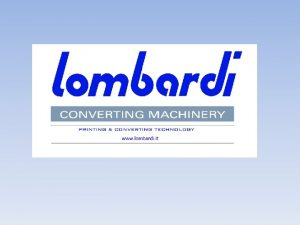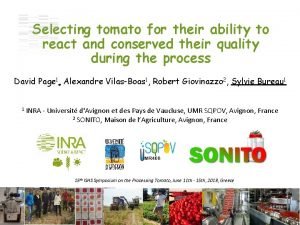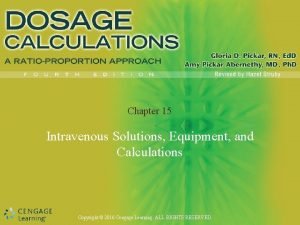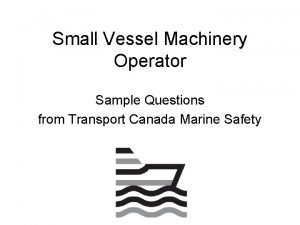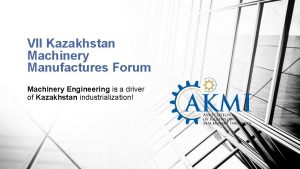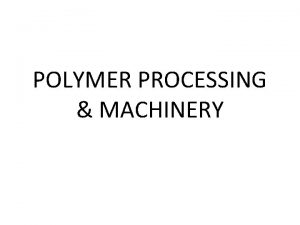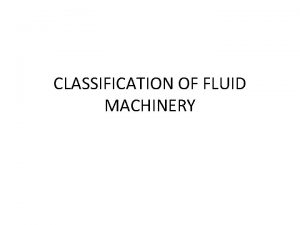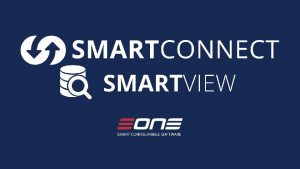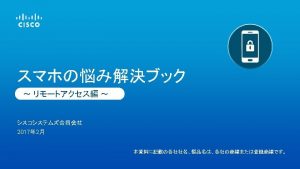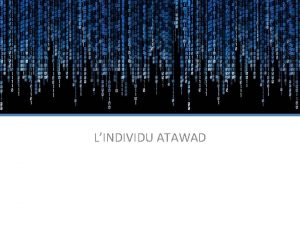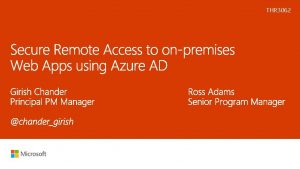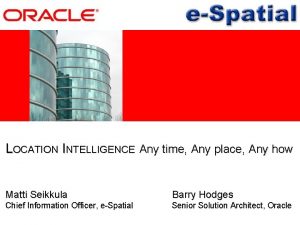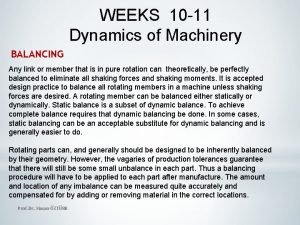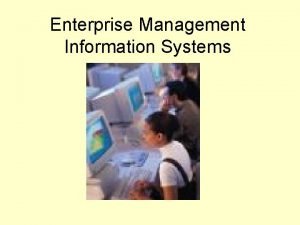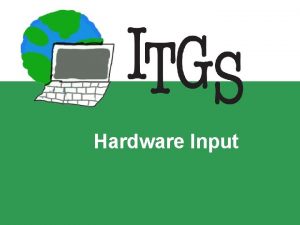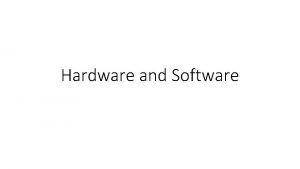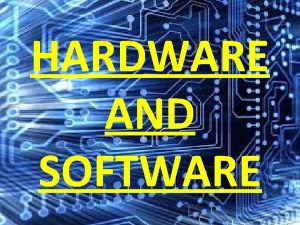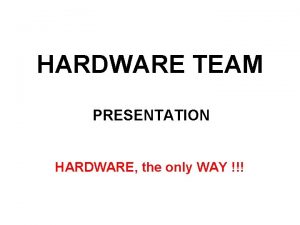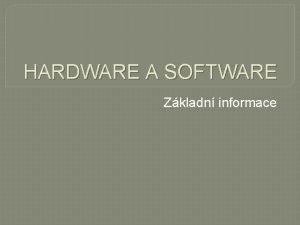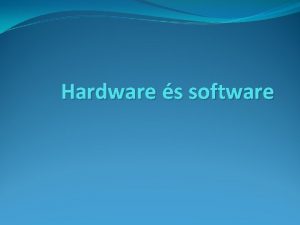Hardware Information Systems and Management Hardware Any machinery





































- Slides: 37

Hardware Information Systems and Management

Hardware Any machinery (with digital circuits) that assists the input, processing, storage, and output activities of an information system.

• Outdated hardware may result in a competitive disadvantage • Hardware must support the software applications which in turn facilitates business operations

Hardware Components • CPU § A/L Unit § Control Unit § Registers • Primary Storage § Holds program instructions and data

The Central Processing Unit A/L Unit (Calculator) Input (In-Basket) Output Control (you) (Out-Basket) Primary Storage (Programs & Data) Special Purpose Processors -Registers Cache Memory -Buffers Phone: I/O Device Garbage: O Device (1 day storage) Desk Radio: I Device only Secondary Storage (File Cabinet)

Hardware Components in Action Execution of any machine – Level instruction • Instruction Phase Step 1: Fetch instructions Step 2: Decode and pass to appropriate unit Instruction time: Time it takes to perform this phase

• Execution Phase Step 3: Carry out the instruction Step 4: Store result in register or memory Execution time: Time it takes to perform this phase

• Machine Cycle Steps 1 – 4 • Pipelining • Each step is active at the same time • Pentium 4 can execute 2 instructions per machine cycle

Processing Characteristics and Functions » Machine Cycle Time » Clock Speed » Micro Code » BIT » Word Length » Bus Line

Machine Cycle Time • Time to execute a machine cycle – Micro second (one millionth) – Pico second (one trillionth) • Instructions per second – MIPS (millions of instructions per second)

Clock Speed • Electronic pulses produced at a predetermined rate that affects machine cycle time – Hertz: one cycle per second – Mega Hertz: millions of cycles per second – Giga Hertz: billions of cycles per second

Micro code • Predefined, elementary circuits and logical operations that the processor performs when it executes an instruction

BIT • BIT: Binary Digit (1 or 0) • Word length: number of bits the CPU can process at any one time – The larger the word length the more primary memory locations can be directly addressed • Requires more sophisticated system software

Bus Line • Queue at a bus stop • Physical system component connections

Physical Characteristics of the CPU • Collections of digital circuits imprinted on silicon wafers • An electrical current must flow from points A to B to turn digital circuit “on” or “off” • To increase speed • Decrease distance • Reduce Resistance

Moore’s Law Densities on a single chip will double every 18 months. • Reduce resistance • Super conductivity: metals that facilitate current flow (gallium arsenide) • Optical processors: light waves

Complex Instruction Set Computing CISC: a computer chip design that places as many microcode instructions into the CPU as possible Reduced Instruction Set Computing RISC: a computer chip based on reducing the number of microcode instructions built into a chip to an essential set of common microcode instructions

• Most operations of a CPU involve only 20% of the available microcode instructions • RISC Chips • Less expensive to produce • More reliable • Faster processing • Fewer microcode steps • Use Pipelining

Memory Characteristics • Main Memory – Provides CPU with working storage for program instructions and data • Storage Capacity – Byte: 8 bits that together represent a single character of data

Types of Memory • Random Access Memory (RAM) – Instructions or data can be temporarily stored – Volatile: lost when power is turned off • Read Only Memory (ROM) – Permanent storage of data and instructions for start-up activities – Non-volatile: retained with no power • Cache Memory – High speed memory that a CPU can access more rapidly than main memory – Example: recently accessed web pages

Multi programming : The simultaneous execution of two or more programs at the same time – NOT!

• Co-Processor • Executes instructions while the CPU works on another activity • Massively Parallel Processing • Linking processors to work at the same time • Simulations • Symmetrical Multiprocessing • Share CPU resources • Grid Computing • Collection of computers – SETI • Central Server

Secondary Storage: Devices that store large amounts of data, instructions and information more permanently than allowed with main memory.

Access Methods • Sequential – Data are accessed in the order in which it is stored • Direct – Data can be retrieved without the need to read and discard other data • Index – Create a separate file with record key and physical address • Index non-sequential (telephone book) • Index sequential (postal code)

Secondary Storage Devices • • • Magnetic tape Magnetic Disc RAID Disc Mirroring Virtual Tape Optical Disc • DVD • Magneto-optical (MO) Disk • Memory Card • Flash Memory • Expandable Storage

Enterprise Storage Options • Network Attached Storage (NAS) – Store data on the network not the computer

Input & Output Devices • Data Entry – Process by which human readable data are converted into machine readable form • Data Input – Process that involves transferring machinereadable data into the system • Source Data Automation – Capturing and editing data where the data are intially created and in a form that can be directly input into a computer, thus, ensuring accuracy and timeliness

Input Devices • • • Personal Computer Input Devices Voice Recognition Digital Cameras Terminals Scanning Devices Point of Sale (POS) Automated Teller Machines (ATM) Pen Input Light Pen Touch Sensitive Radio Frequency Identification (RFID)

Output Devices • Display Monitors • TV-screen-like device • Pixel: a dot of colour on a photo image or a point of light on a display screen. • CRT : Cathode Ray Tube • LCD: Liquid Crystal Display • LED: Light-emitting Diode • Printers & Plotters • Computer Output Microfilm (COM) • Music Devices

Input/Output • Voice • Optical • OMR • OCR • Bar Codes and UPC • Magnetic Ink (MICR) • RFID • Source Data Automation

Computer System Types • • Handheld Portable Thin Client Desktop Workstation Server Mainframe Supercomputers

Scalability: The ability to increase the capability of the computer to process more transactions in a given period by adding more, or more powerful processors.

Selecting & Upgrading Computer Systems • • • Computer system architecture Hard Drive Main Memory Printers DVD Burner • Support Fundamental Objectives • Current and Future Business Needs

Major Trends in Computer System Capabilities Size (Typical computers) Circuitry First Second Generation Third Generation Fourth Generation Fifth generation? Room Size Mainframe Closet Size Mainframe Desk-size Minicomputer Desktop & Laptop Networked Computers Vacuum Tubes Transistors Integrated Semiconductor Circuits Large-Scale Integrated (LSI) Semiconduct or Circuits Very-Large. Scale Integrated (VLSI) Semiconduct or Circuits

General Trend • Smaller • Faster • More Power • More Reliable • Cheaper • For the functionality

Terms • Multiprocessors • More than one CPU • Multi programming • More than one program “resident” in CPU • Only one can run • Multitasking • Multiprogramming on a micro

Hardware Information Systems and Management
 Hardware of information system
Hardware of information system Hardware internal and external
Hardware internal and external There isn't any burger
There isn't any burger Any to any connectivity
Any to any connectivity Seknder
Seknder Knowledge management and specialized information systems
Knowledge management and specialized information systems Plant and machinery valuation
Plant and machinery valuation Plant and machinery valuation
Plant and machinery valuation Classification of plant and machinery
Classification of plant and machinery Alan turing computing machinery and intelligence
Alan turing computing machinery and intelligence Management information system chapter 1
Management information system chapter 1 Management information systems example
Management information systems example Definition of mis
Definition of mis Information systems management in practice
Information systems management in practice Vertical
Vertical Management information systems wiley
Management information systems wiley Voyage estimating decision support system
Voyage estimating decision support system Management information systems effy oz
Management information systems effy oz Introduction to management information systems 5th edition
Introduction to management information systems 5th edition Management information systems managing the digital firm
Management information systems managing the digital firm Introduction of management information system
Introduction of management information system Introduction to management information system
Introduction to management information system Interaction model in distributed system
Interaction model in distributed system Smb machinery
Smb machinery School grievance committee
School grievance committee Namsun machinery
Namsun machinery Divine machinery definition
Divine machinery definition Types of machinery
Types of machinery Administrative machinery
Administrative machinery Grievance machinery in deped
Grievance machinery in deped Plastics machinery manufacturers association of india
Plastics machinery manufacturers association of india Indian pharma machinery manufacturers association
Indian pharma machinery manufacturers association Lombardi printers
Lombardi printers Tomato hb machinery
Tomato hb machinery Iv calculation formula
Iv calculation formula Grandfather clause apush
Grandfather clause apush Wage regulation machinery
Wage regulation machinery Small vessel machinery operator certificate program
Small vessel machinery operator certificate program
